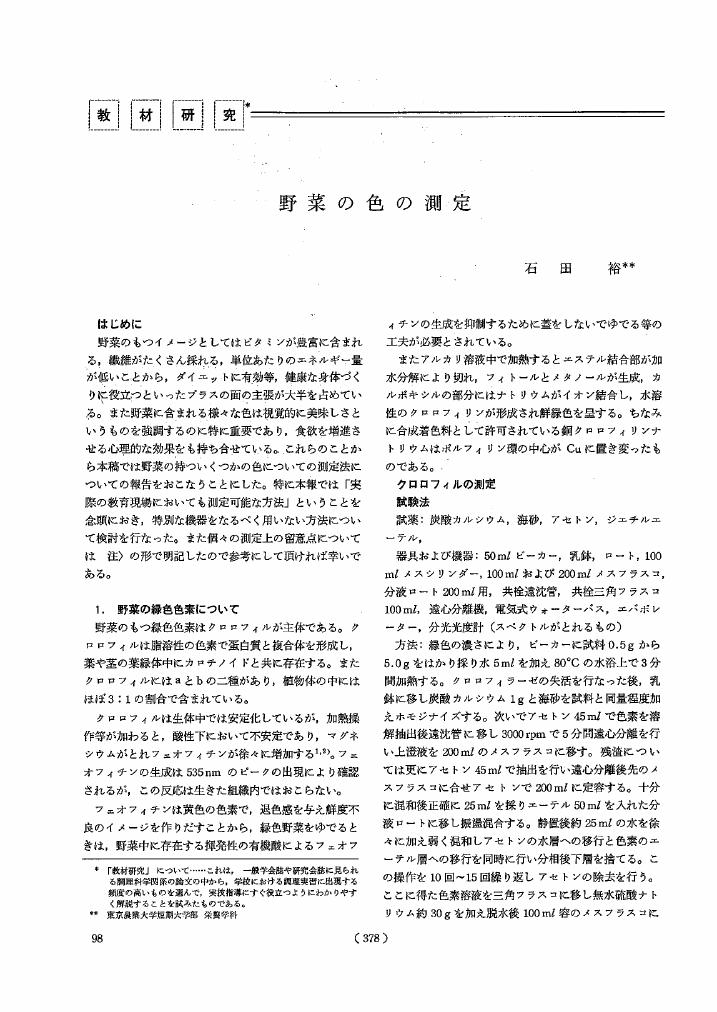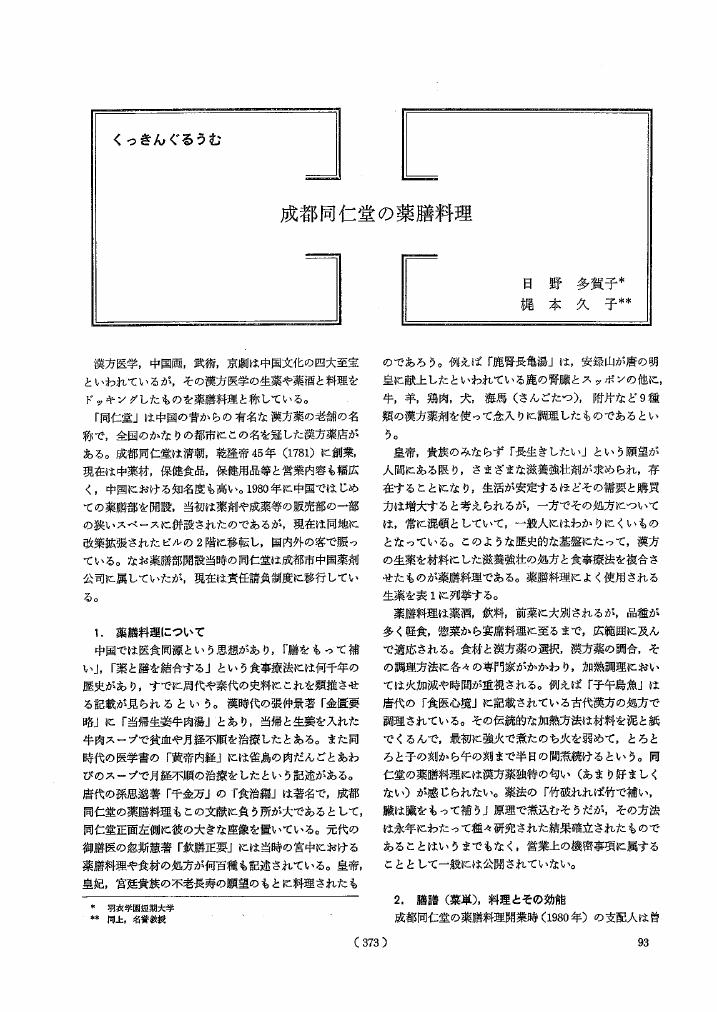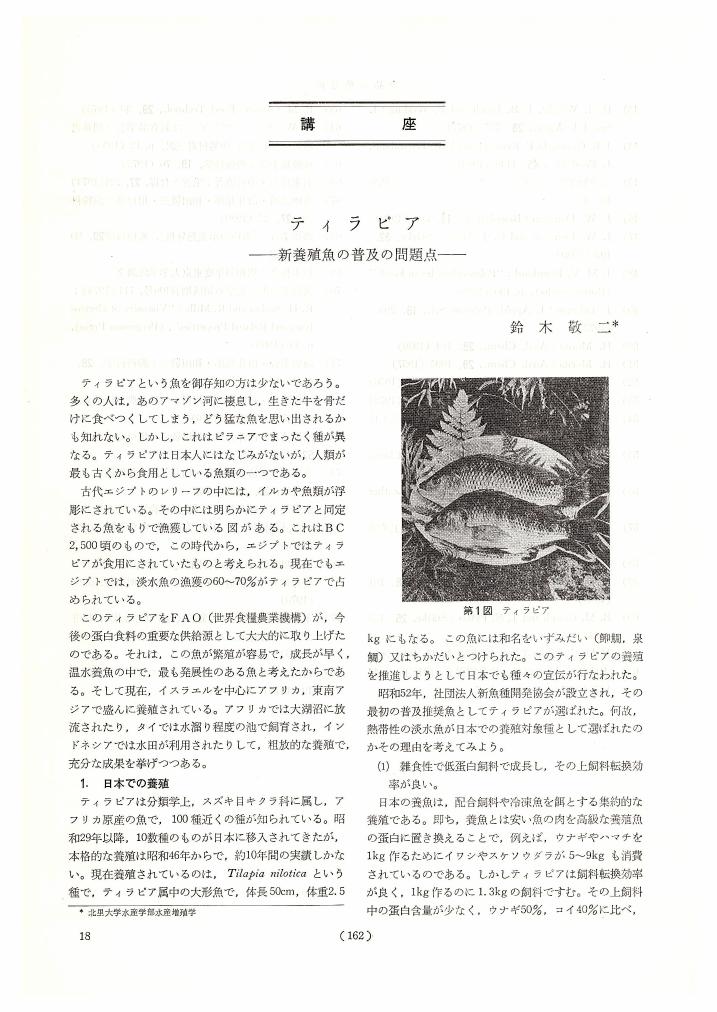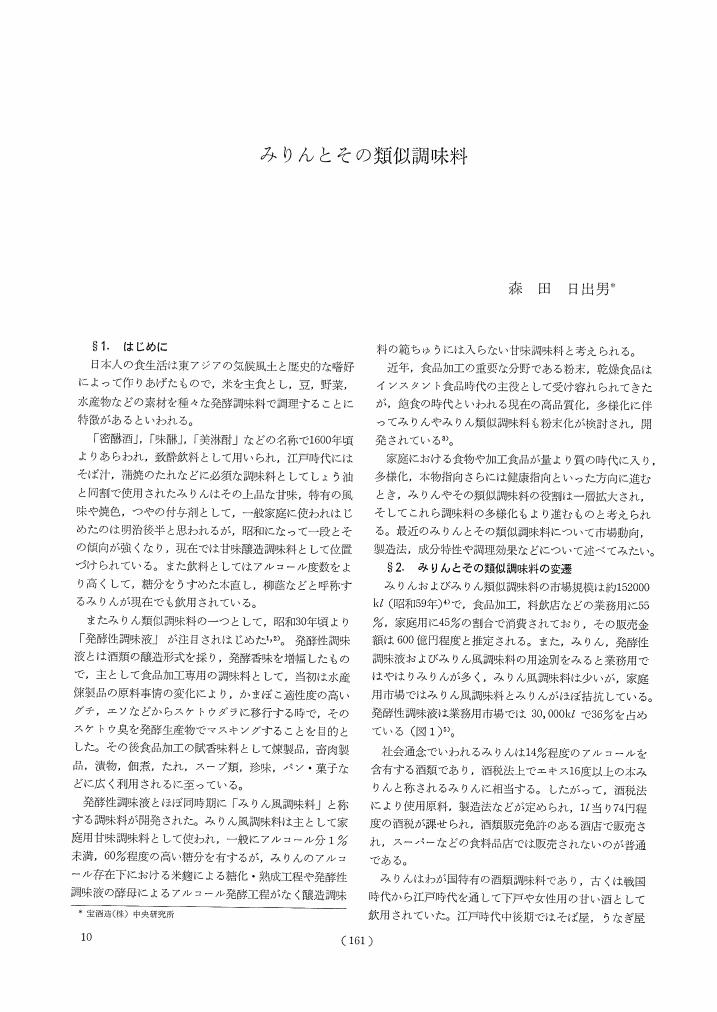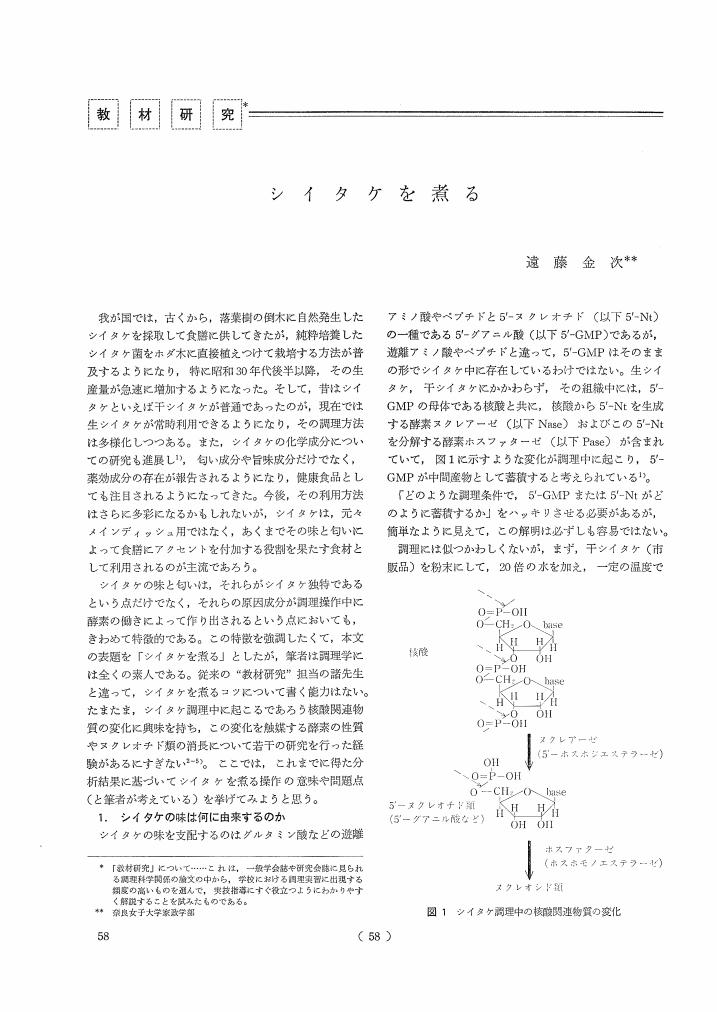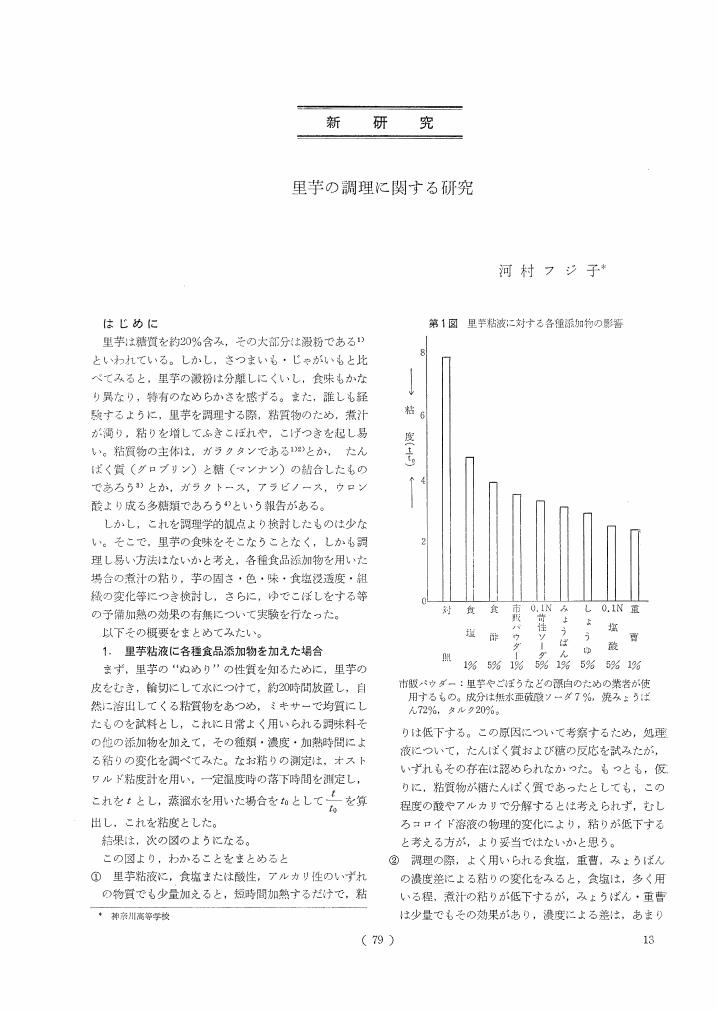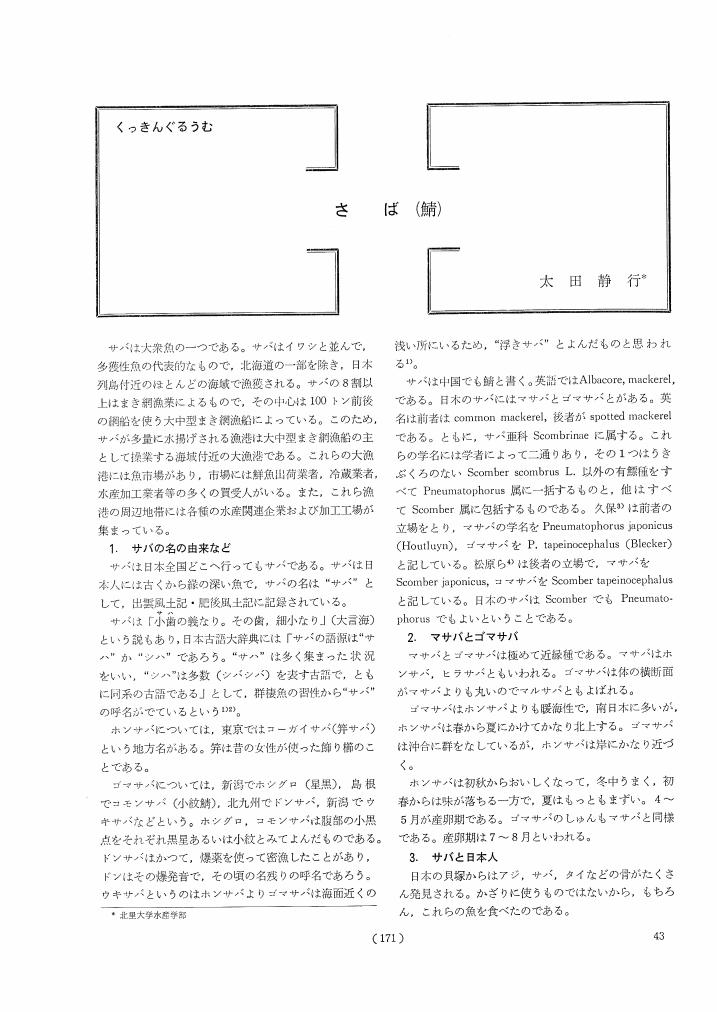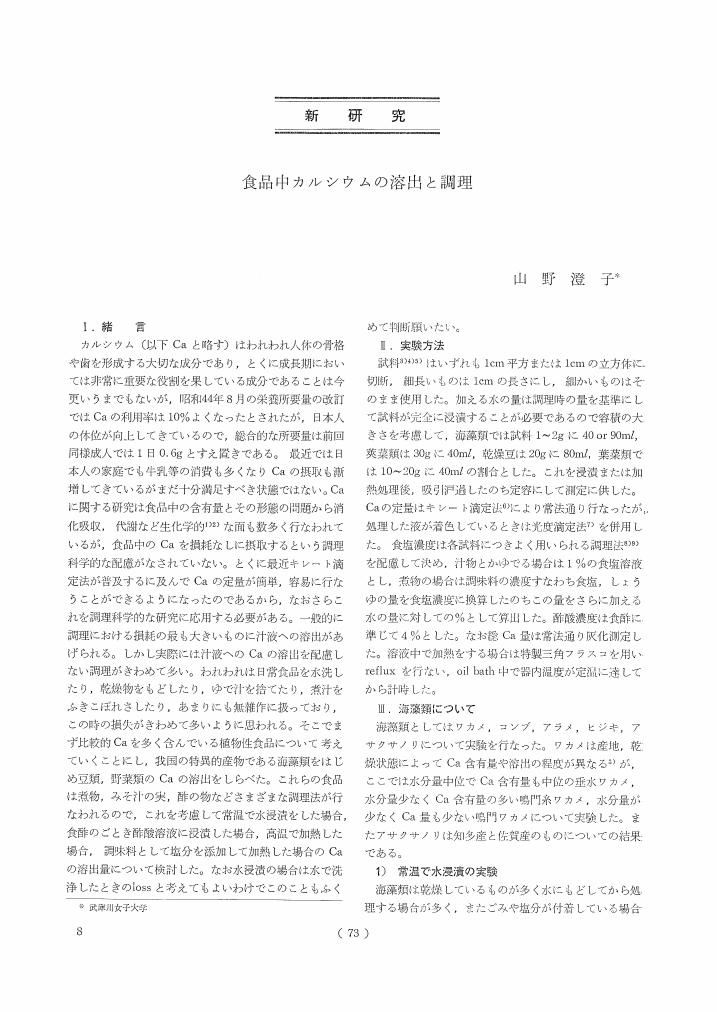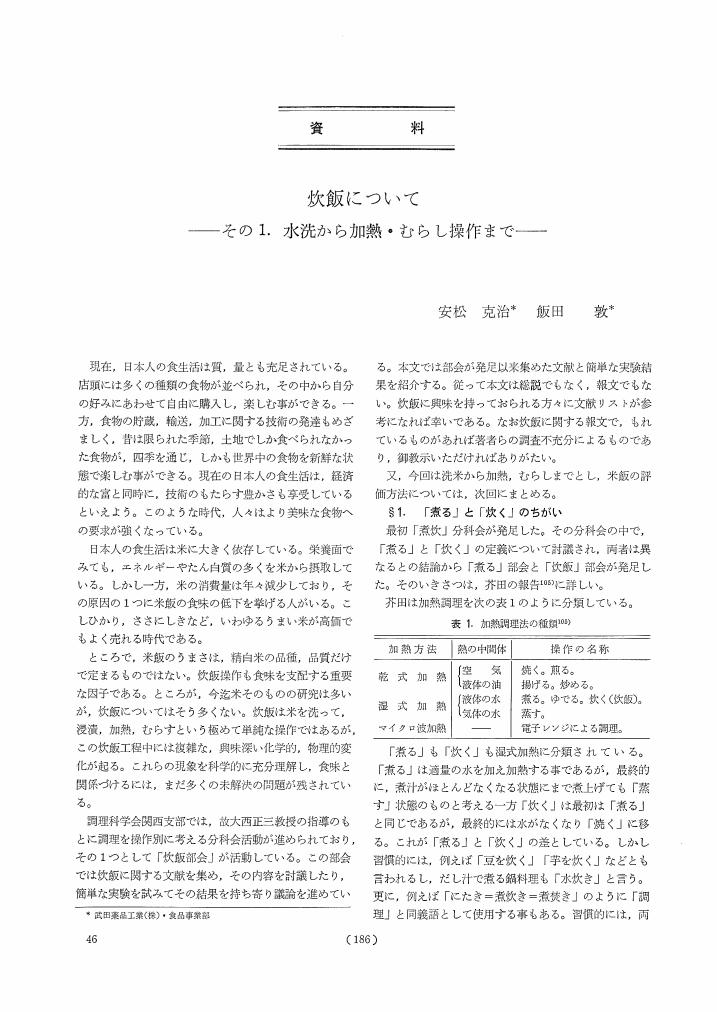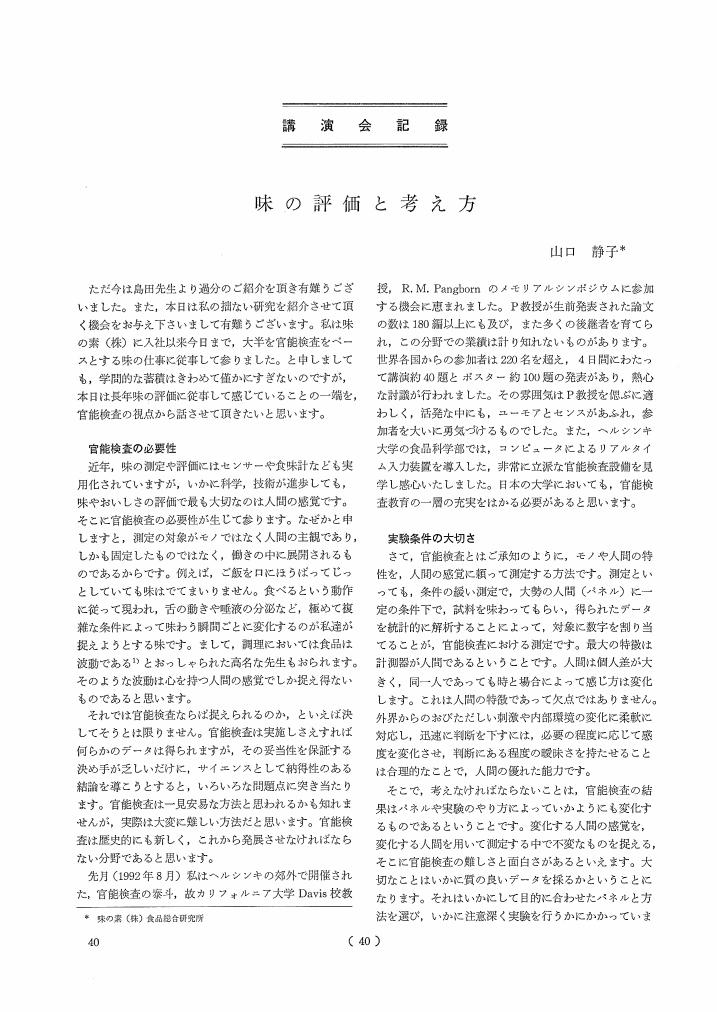1 0 0 0 OA 古い料理書の話
- 著者
- 川上 行蔵
- 出版者
- 一般社団法人 日本調理科学会
- 雑誌
- 調理科学 (ISSN:09105360)
- 巻号頁・発行日
- vol.9, no.4, pp.210-214, 1976-12-20 (Released:2013-04-26)
1 0 0 0 OA 野菜の色の測定
- 著者
- 石田 裕
- 出版者
- 一般社団法人 日本調理科学会
- 雑誌
- 調理科学 (ISSN:09105360)
- 巻号頁・発行日
- vol.26, no.4, pp.378-384, 1993-11-20 (Released:2013-04-26)
- 参考文献数
- 18
- 被引用文献数
- 3
1 0 0 0 OA 酢漬け魚肉の調理
- 著者
- 下村 道子
- 出版者
- 一般社団法人 日本調理科学会
- 雑誌
- 調理科学 (ISSN:09105360)
- 巻号頁・発行日
- vol.19, no.4, pp.276-280, 1986-12-20 (Released:2013-04-26)
- 参考文献数
- 10
- 被引用文献数
- 1
1 0 0 0 OA 明治時代の文献による調理学研究 その1.調理食品の消化吸収率 軍医学校での成績(1)
- 著者
- 山下 光雄
- 出版者
- 一般社団法人 日本調理科学会
- 雑誌
- 調理科学 (ISSN:09105360)
- 巻号頁・発行日
- vol.21, no.1, pp.20-29, 1988-06-20 (Released:2013-04-26)
- 被引用文献数
- 1
1 0 0 0 OA つなぎの違いによるそば切りの経時的変化
- 著者
- 堤 ちはる 山岸 純子 本山 百合子 三橋 扶佐子 吉中 哲子
- 出版者
- 一般社団法人 日本調理科学会
- 雑誌
- 調理科学 (ISSN:09105360)
- 巻号頁・発行日
- vol.23, no.4, pp.373-381, 1990-11-20 (Released:2013-04-26)
- 参考文献数
- 5
- 被引用文献数
- 4
The texture parameters and the characteristics of tissues of the four kinds of buckwheat noodles with different thickenings, SOBANERI, flour, yam (ICHO-IMO), and egg used in each buckwheat. Their time changes were observed.The four kinds of buckwheat needles were stored at the temperature of 20°C and 5°C during the experiment, and time changes were evaluated by the sensory test and observed by using a scan type electron microscope.1) Buckwheat noodles with flour used as thickening Right after boiling it, ductile fracture and the maximum rupture energy and distortion were seen. Though the change on standing was big, it was hard to be cut compare with the other three kinds. This phenomenon correlates with the result of the sensory test.2) Buckwheat noodles with egg used as thickening Right after boiling it, its hardness is the biggest and the time change low. The actual hardness correlates with the result of the sensory test.3) Tomotsunagi and Imotsunagi noodles Both the hardness and rupture energy were small. Therefore, they seemed to be cut easily.4) By the observation with an electron microscope, the change at the preservation time and temperature became slow by using TSUNAGI.
1 0 0 0 OA エリスリトールの甘味質と調理への利用
- 著者
- 青山 佐喜子 高田 修代 藤原 耕三
- 出版者
- 一般社団法人日本調理科学会
- 雑誌
- 調理科学 (ISSN:09105360)
- 巻号頁・発行日
- vol.25, no.1, pp.8-14, 1992-02-20
- 被引用文献数
- 1
エリストールとしょ糖の混合溶液及びエリストールを各種調理に用いた場合のし好について官能検査を行い次の結果を得た。1.しょ糖溶液7%を基準にその甘味の25%、50%、75%、100%をエストリールで置き換えた場合に25%置き換えた試料とエリストールだけの試料の収れん味と総合評価の項目には、5%の危険率で有意差があったが、その他の項目にはなかった。2.レモンスカッシュのような酸味のある飲料にエリストールを用いた場合は、しょ糖とし好の差はなく、しょ糖濃度約12%と低いため低温でも溶解しやすく、飲料はエリストールの利用に適していると考えられた。3.ゼリーは甘味だけの場合、酸味を加えた場合とも、各項目についてしょ糖との間にし好の差はなかった。4.アイスクリームやシャーベットのようなエリストールを冷凍する場合には硬くなる傾向がみられたが、甘味を50%置換した場合にはその傾向は少なく、冷菓において、甘味の一部にエリストールを用いることは可能であると思われた。5.水ようかんはしょ糖濃度が高く、冷やして食するためにエリストールだけでは利用できなかった。甘味の50%をエリストールで置換した試料(SE)の総合評価は5%の危険率で好まれなかった。6.しるこの甘味の20%、40%をエリストールに置き換えた場合、エリストール40%の試料(SE40%)は、口ざわりが好まれず、しょ糖より後味が乏しく感じられた。しかし、エリストール20%の試料(SE20%)としょ糖には差はなかった。7.一般のそう菜に利用した場合、エリストールの甘味質があっさりしているため、他の調味料の味が後味として残る傾向があると思われた。日常の低甘味度での煮物や酢の物にしょ糖の一部または全部を置き換えてエリストールを用いることが可能であった。
1 0 0 0 OA 成都同仁堂の薬膳料理
- 著者
- 日野 多賀子 梶本 久子
- 出版者
- 一般社団法人 日本調理科学会
- 雑誌
- 調理科学 (ISSN:09105360)
- 巻号頁・発行日
- vol.26, no.4, pp.373-377, 1993-11-20 (Released:2013-04-26)
- 参考文献数
- 5
1 0 0 0 OA ティラピア 新養殖魚の普及の問題点
- 著者
- 鈴木 敬二
- 出版者
- 一般社団法人 日本調理科学会
- 雑誌
- 調理科学 (ISSN:09105360)
- 巻号頁・発行日
- vol.14, no.3, pp.162-165, 1981-10-20 (Released:2013-04-26)
1 0 0 0 OA みりんとその類似調味料
- 著者
- 森田 日出男
- 出版者
- 一般社団法人 日本調理科学会
- 雑誌
- 調理科学 (ISSN:09105360)
- 巻号頁・発行日
- vol.19, no.3, pp.161-169, 1986-12-20 (Released:2013-04-26)
- 参考文献数
- 16
1 0 0 0 OA シイタケを煮る
- 著者
- 遠藤 金次
- 出版者
- 一般社団法人 日本調理科学会
- 雑誌
- 調理科学 (ISSN:09105360)
- 巻号頁・発行日
- vol.22, no.1, pp.58-62, 1989-03-20 (Released:2013-04-26)
- 参考文献数
- 9
- 被引用文献数
- 3
1 0 0 0 OA 里芋の調理に関する研究
- 著者
- 河村 フジ子
- 出版者
- 一般社団法人 日本調理科学会
- 雑誌
- 調理科学 (ISSN:09105360)
- 巻号頁・発行日
- vol.3, no.2, pp.79-85, 1970-06-20 (Released:2013-04-26)
- 参考文献数
- 6
- 著者
- 板橋 雅子
- 出版者
- 一般社団法人 日本調理科学会
- 雑誌
- 調理科学 (ISSN:09105360)
- 巻号頁・発行日
- vol.15, no.4, pp.229-231, 1982
すんきの栄養学的効果を知る日的で,すんき漬法による試料とこれに類似する数種の漬け方の試料の成分をそれぞれ分析して以下の結果を得た.<BR>1)すんき漬法では漬種の有無に拘らず,原料中の粗たんぱく質の損失が非常に少ない.<BR>2)すんき漬と同様の漬込操作でも,食塩を5%添加すると粗たんぱく質のほぼ半量が失なわれる.<BR>3)漬込過程中に,原料中の遊離アミノ酸および粗たんぱく質の分解によるアミノ酸は漬汁中に溶出するが,乳酸菌による乳酸濃度が大であると,粗たんぱく質の分解が少ない上に,アミノ酸の漬汁中への溶出が抑制されるものと考えられる.
1 0 0 0 すんきに関する研究(第1報):すんきの栄養学的成分について
- 著者
- 板橋 雅子
- 出版者
- 一般社団法人 日本調理科学会
- 雑誌
- 調理科学 (ISSN:09105360)
- 巻号頁・発行日
- vol.15, no.4, pp.226-228, 1982
The “Sunki”, a kind of Japanese pickles peculiar in Kiso district, Nagano pref. is pickled without salt under lower temperature (winter season), then dried and preserved throughout the year. And so, it is considered to be available for preserving green vegitables and for providing dietary fibers protecting so-called adult-disease.<BR>The auther studied the dietetic components of the Sunki and its pickling conditions concerning with sample A (produced in Ohtaki village, Kiso district) and sample B (prepared in our laboratory under strict temperature conditioning) obtaining following results.<BR>1. Appearance and taste of the pickles; sample A was inferior in comparison with sample B.<BR>2. The pH of the pickling liquid; Sample A increased acidity with passing time, otherhand sample B held neary nutral throughout period.<BR>3. Free amino acid in the pickles; sample B contained less than sample A.<BR>4. Crude protein remaining in the pickles; sample B contained more than sample A, and its quantity is almost equal to that in the raw greens.<BR>In conclusion, it was demonstrated that the strict temperature conditioning (about -5°C) is necessary for producing good Sunki.
1 0 0 0 OA 甘味に対する味覚嗜好性について
- 著者
- 三浦 春恵
- 出版者
- 一般社団法人 日本調理科学会
- 雑誌
- 調理科学 (ISSN:09105360)
- 巻号頁・発行日
- vol.2, no.2, pp.85-91, 1969-05-20 (Released:2013-04-26)
- 参考文献数
- 18
1 0 0 0 OA 市販中国野菜の無機成分の加熱調理による変化
- 著者
- 酒向 史代 森 悦子 渡部 博之
- 出版者
- 一般社団法人日本調理科学会
- 雑誌
- 調理科学 (ISSN:09105360)
- 巻号頁・発行日
- vol.27, no.3, pp.191-196, 1994-08-20
- 被引用文献数
- 2
中国野菜のタアサイ、チンゲンサイ、クキニンニクについて、各種調理後の9種の無機成分の含有量の変化を検討した。1)生のタアサイ、チンゲンサイの各部位の含有量を比較すると、Mn、Zn、Cu、Feは葉身が葉柄の2.5〜8.5倍であった。2)タアサイは、葉身の水ゆで、塩ゆでのK、葉柄塩ゆでのFeで残存率が33〜47%と低くなった。3)チンゲンサイは葉身の炒め操作で、Pの残存率が55%で最も低かった。4)クキニンニクは顕著な損失がなく、いずれの無機成分も残存率が67%以上であった。5)これまでに報告されている野菜類と比較すると、全体に残存率が高かった。本研究の概要は、平成5年度日本調理科学会において発表した。
1 0 0 0 OA さば(鯖)
- 著者
- 太田 静行
- 出版者
- 一般社団法人 日本調理科学会
- 雑誌
- 調理科学 (ISSN:09105360)
- 巻号頁・発行日
- vol.15, no.3, pp.175-178, 1982-10-20 (Released:2013-04-26)
- 参考文献数
- 18
1 0 0 0 OA 食品中カルシウムの溶出と調理
- 著者
- 山野 澄子
- 出版者
- 一般社団法人 日本調理科学会
- 雑誌
- 調理科学 (ISSN:09105360)
- 巻号頁・発行日
- vol.4, no.2, pp.73-80, 1971-06-20 (Released:2013-04-26)
- 参考文献数
- 10
1 0 0 0 OA 調理による食品中の添加物の減少(1) ―ハム中の亜硝酸塩の減少―
- 著者
- 伊藤 和男 山本 信彦 伊藤 美都子
- 出版者
- 一般社団法人 日本調理科学会
- 雑誌
- 調理科学 (ISSN:09105360)
- 巻号頁・発行日
- vol.26, no.2, pp.127-129, 1993-05-20 (Released:2013-04-26)
- 参考文献数
- 5
The decrease of nitrite in ham during cooking process was investigated.Hams containing 64.1mg/kg of nitrite were used to estimate the decrease of nitrite.60 percent of nitrite was decreased after boiling ham in water for 20 seconds. But after boiling in water containing one weight percent of vinegar or sake, only 30 percent of nitrite was decreased.After soaking ham in water at room temperature for 1 minute,60 percent of nitrite was decreased. Fifty percent of nitrite was decreased by sauteeing with butter or margarin for 30 seconds, and only 30 percent of nitrite by sauteeing with corn oil.Consequently, fair amount of nitrite was removed from hams during the simple cooking process.
1 0 0 0 OA 炊飯について その1.水洗から加熱・むらし操作まで
- 著者
- 安松 克治 飯田 敦
- 出版者
- 一般社団法人 日本調理科学会
- 雑誌
- 調理科学 (ISSN:09105360)
- 巻号頁・発行日
- vol.18, no.3, pp.186-193, 1985-09-20 (Released:2013-04-26)
- 参考文献数
- 111
- 被引用文献数
- 1
1 0 0 0 OA 味の評価と考え方
- 著者
- 山口 静子
- 出版者
- 一般社団法人 日本調理科学会
- 雑誌
- 調理科学 (ISSN:09105360)
- 巻号頁・発行日
- vol.26, no.1, pp.40-46, 1993-02-20 (Released:2013-04-26)
- 参考文献数
- 13

